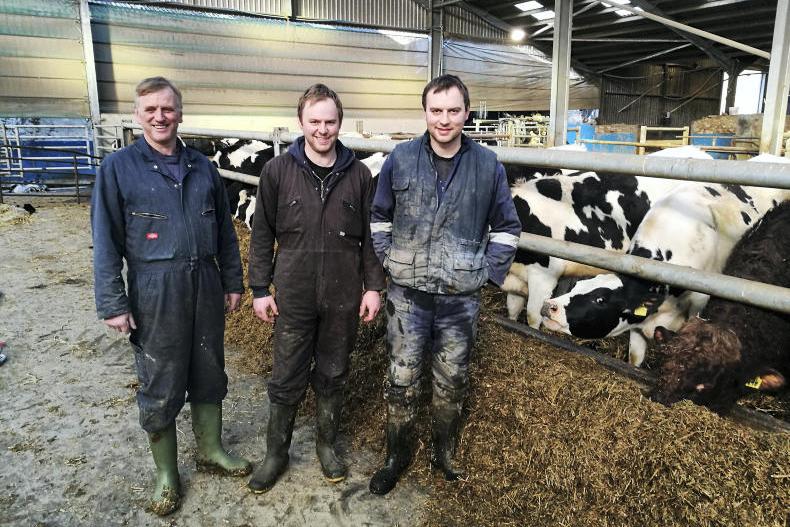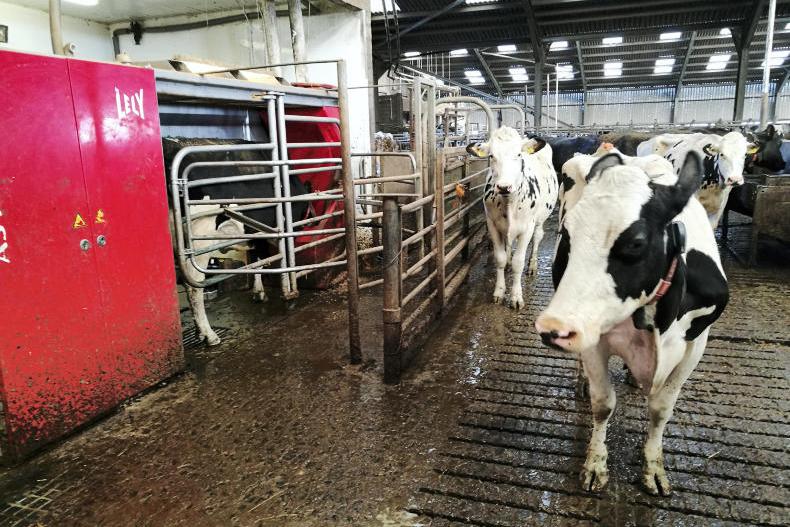Colin Marr along with his two sons Nicholas and Gavin have invested heavily to build an efficient dairy farm in the northeast of Scotland.
Speaking to the Farmers Journal Scotland, Colin explained that in 2007, when his sons came back from university and college, they made the decision to replace their 1976 16/16 herringbone dairy parlour with state-of-the-art robots housed in new steadings.
Supported through some SRDP grants, the Marrs have a great set up with around 220 cows in a silage-based system.
Output and breeding
The herd is all Holstein, with a focus on efficient production and high welfare. Colin explained: “The reason to keep the cows inside was to allow greater attention to detail and improved welfare, particularly their feet with weekly footbaths.”
The breeding program is greatly influenced by computer information from the robots which help select straws of semen. Colin likes a young herd with lots of new heifers entering the herd each year. Replacement heifers cost just over £900 to rear.
This helps keep instances of mastitis low along with fewer issues with cell counts. Calving interval is around 400 days.
“Feeding the cows while in the robots has reduced fighting between older cows and younger heifers, resulting in higher heifer milk yields. Despite a focus on youth, we have some good performing cows 10 years old on the farm,” Colin said.
This is a high output farm with an average yield of 11,500l of milk per cow per year.
The cattle are fed around 4t concentrates per year along with 9t to 10t of silage.
This equates to 0.38kg of feed per litre of milk. The indoor system means that output is very consistent throughout the year avoiding price reductions on account of variable lactation curves which are inevitable in a grazing system.
Markets
Most of their milk goes on a Tesco contract, which has reduced their exposure to the volatility in the recent milk market.
He is one of the seven Tesco contracts in the north east of Scotland. The recent closure of the processing plant in Aberdeen means that their milk is sent 170 miles south to a plant in Paisley.
Tesco contacts have an increased number of hoops to jump through for the farmer. The Marrs are required to do regular foot and mobility scoring, attend technical meetings along with transparency on their cost of production and finances. Tesco is also looking to identify the poorest performing farms in their milk pool and offer them additional support.
Robots
The decision to install four Lely robots has allowed their dairyman to be employed from 7.30am to 5pm with the family covering the maintenance at night.
The robots cost around £100,000 each to get them to the farm.
“I hope the robots will last 12 years and I’ve heard of some lasting 15,” Colin said.
Their longevity is based on the amount of milking, with his getting 2,000l of milk a day.

The cattle are fed silage made from 300ac of grass. They hope to get 8t an acre for the first cut with 4t the second and a third can be very variable. Cattle also get fed treated barley and wheat from 600ac of arable ground and bought in protein and distillery by-products.
The silage-based system also allows much more attention to be given to the feeding. The basis is a grass silage with soya and processed rape meal added for protein. They treat their grain with caustic soda.
Distillery by-products are not always available, but if Colin could get a regular supply, he would consider building a store which would help reduce the water content.

The slurry is pumped from the cow shed to the slurry store every five days. The store is emptied by a contractor using an umbilical system in the winter and the Marrs compliment this with their tanker in the summer for spreading slurry to farms further away.
The umbilical system can easily pump 1km away from the farm with 2km possible if a second pump is used. This has required innovative solutions to getting pipes under roads and over burns.
Soil fertility
Through regular liming he keeps the pH in the soil at around six for his arable land with grass fields at 5.8. Colin crops around 1.5t for oilseed rape per acre, 3t winter barley per acre and 3.5t to 4t of winter wheat per acre.
Young stock and beef
Colin rears his own young stock on the grass fields surrounding the farm. He also purchased a Saler bull from a neighbour and uses Belgian Blue AI for crossing with cows which are not part of the breeding program.
The dairy bulls are finished on the farm at 12 to 13 months. Colin explained that his bulls are heading further and further south for processing.
Originally, they were going to Woodheads at Turriff then ABP Perth and now to Stoddarts in Ayrshire. The cull cow price is very variable with two recent cows going for £542 and £970 each. But on average they get around £500 a head.
This is a high output farm with a strong family team at the core. It demonstrates how a strong contract, calculated investment and attention to detail can build a strong dairy business.
Read more
Farm Profit Programme: the Duffus family, Tomintoul
Colin Marr along with his two sons Nicholas and Gavin have invested heavily to build an efficient dairy farm in the northeast of Scotland.
Speaking to the Farmers Journal Scotland, Colin explained that in 2007, when his sons came back from university and college, they made the decision to replace their 1976 16/16 herringbone dairy parlour with state-of-the-art robots housed in new steadings.
Supported through some SRDP grants, the Marrs have a great set up with around 220 cows in a silage-based system.
Output and breeding
The herd is all Holstein, with a focus on efficient production and high welfare. Colin explained: “The reason to keep the cows inside was to allow greater attention to detail and improved welfare, particularly their feet with weekly footbaths.”
The breeding program is greatly influenced by computer information from the robots which help select straws of semen. Colin likes a young herd with lots of new heifers entering the herd each year. Replacement heifers cost just over £900 to rear.
This helps keep instances of mastitis low along with fewer issues with cell counts. Calving interval is around 400 days.
“Feeding the cows while in the robots has reduced fighting between older cows and younger heifers, resulting in higher heifer milk yields. Despite a focus on youth, we have some good performing cows 10 years old on the farm,” Colin said.
This is a high output farm with an average yield of 11,500l of milk per cow per year.
The cattle are fed around 4t concentrates per year along with 9t to 10t of silage.
This equates to 0.38kg of feed per litre of milk. The indoor system means that output is very consistent throughout the year avoiding price reductions on account of variable lactation curves which are inevitable in a grazing system.
Markets
Most of their milk goes on a Tesco contract, which has reduced their exposure to the volatility in the recent milk market.
He is one of the seven Tesco contracts in the north east of Scotland. The recent closure of the processing plant in Aberdeen means that their milk is sent 170 miles south to a plant in Paisley.
Tesco contacts have an increased number of hoops to jump through for the farmer. The Marrs are required to do regular foot and mobility scoring, attend technical meetings along with transparency on their cost of production and finances. Tesco is also looking to identify the poorest performing farms in their milk pool and offer them additional support.
Robots
The decision to install four Lely robots has allowed their dairyman to be employed from 7.30am to 5pm with the family covering the maintenance at night.
The robots cost around £100,000 each to get them to the farm.
“I hope the robots will last 12 years and I’ve heard of some lasting 15,” Colin said.
Their longevity is based on the amount of milking, with his getting 2,000l of milk a day.

The cattle are fed silage made from 300ac of grass. They hope to get 8t an acre for the first cut with 4t the second and a third can be very variable. Cattle also get fed treated barley and wheat from 600ac of arable ground and bought in protein and distillery by-products.
The silage-based system also allows much more attention to be given to the feeding. The basis is a grass silage with soya and processed rape meal added for protein. They treat their grain with caustic soda.
Distillery by-products are not always available, but if Colin could get a regular supply, he would consider building a store which would help reduce the water content.

The slurry is pumped from the cow shed to the slurry store every five days. The store is emptied by a contractor using an umbilical system in the winter and the Marrs compliment this with their tanker in the summer for spreading slurry to farms further away.
The umbilical system can easily pump 1km away from the farm with 2km possible if a second pump is used. This has required innovative solutions to getting pipes under roads and over burns.
Soil fertility
Through regular liming he keeps the pH in the soil at around six for his arable land with grass fields at 5.8. Colin crops around 1.5t for oilseed rape per acre, 3t winter barley per acre and 3.5t to 4t of winter wheat per acre.
Young stock and beef
Colin rears his own young stock on the grass fields surrounding the farm. He also purchased a Saler bull from a neighbour and uses Belgian Blue AI for crossing with cows which are not part of the breeding program.
The dairy bulls are finished on the farm at 12 to 13 months. Colin explained that his bulls are heading further and further south for processing.
Originally, they were going to Woodheads at Turriff then ABP Perth and now to Stoddarts in Ayrshire. The cull cow price is very variable with two recent cows going for £542 and £970 each. But on average they get around £500 a head.
This is a high output farm with a strong family team at the core. It demonstrates how a strong contract, calculated investment and attention to detail can build a strong dairy business.
Read more
Farm Profit Programme: the Duffus family, Tomintoul








 This is a subscriber-only article
This is a subscriber-only article








SHARING OPTIONS: